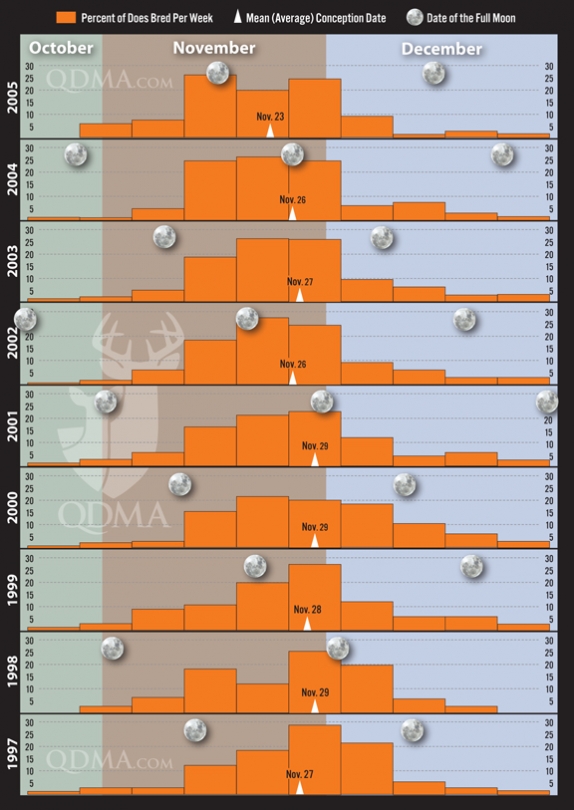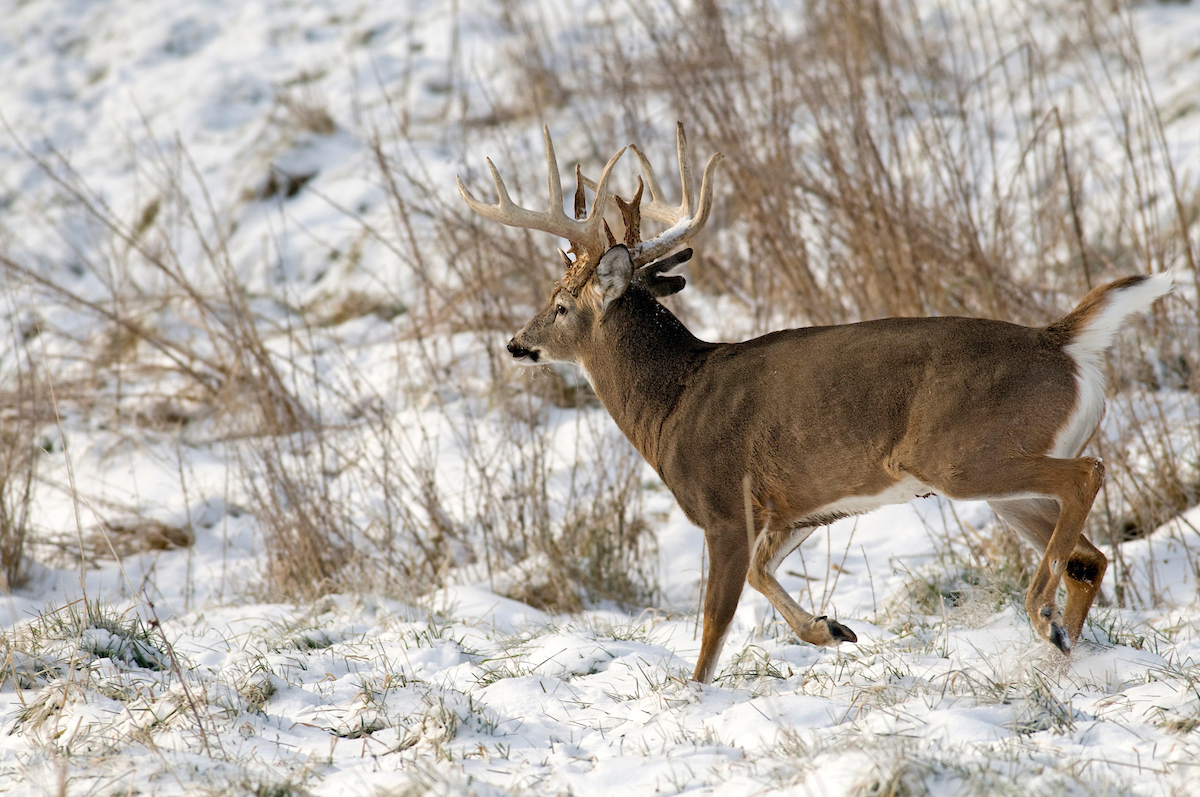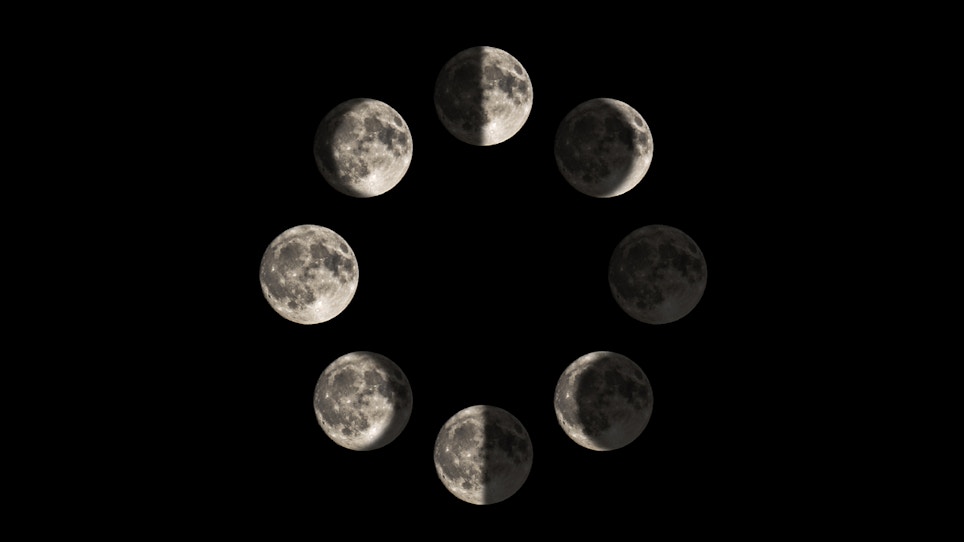Here far away
One could feel the earth vibrate
Moon changing shape and shade
As we all do under its gaze
Yellow moon on the rise
Yellow moon
— Pearl Jam
There’s no link between moon phase and rut peak. This was widely reported by hunting blogs and publications several years ago. But who wants to hear that? After all, a lot of us deer hunters were brought up with the understanding that moon phases do indeed have great bearing on the deer rut, and now science suggests it doesn’t.
And, as a result, plenty of hunters not only didn’t want to hear it, they simply didn't hear it.
One bowhunter from Florida wrote, “the rut seems to get going pretty good during the October new moon around here.” A Kentucky deer hunter puts less emphasis on the moon but has his preferences. For him, the new moon being right around Halloween, was not an optimal phase. “I'd rather see a waining gibbous/crescent or full, but the rut is still going to happen at the same time. Give me a major cold front any day over a favorable moon that time of year. When you have both, it makes for amazing movement though," he wrote. Another common theory is that the “rutting moon” or the second full moon after the autumn equinox, affects peak whitetail breeding, but the Quality Deer Management Association (QDMA) says not so much to all of these moon-centric theories.
Let’s look at this graphic published by QDMA’s Quality Whitetails magazine. It shows what science has been telling the deer-hunting community: There is no correlation between the moon and whitetail breeding.

The bars represent the percentage of each year's sample of does bred per week from late October through the end of December. The moon images are placed on the exact dates of full moons for each year. The mean (or average) conception date for each year is indicated on the chart by the white triangles, with the exact date given. — QDMA
Set Your Sights on the Amount of Daylight, Not Moonlight
Daylight is the big influencer. And if you think about it, this should be intuitive. It’s the amount of daylight that influences when chickens return to their coop, when flowers bloom and when deer breed. The moon just doesn’t have a say in such matters.
For deer breeding specifically, it’s the length of daylight each day, which fluctuates throughout the seasons. The daylight triggers hormone changes in deer that bring on breeding and the rut. Yet, the hunters on the ground, from newbie young hunters to those crusty veteran hunters hold onto the influences of the moon.
According to QDMA, “from 1997 to 2005, biologists with (the small Canadian province of) New Brunswick department of natural resources visited the sites of reported deer road-kills to collect biological data, including fetal measurements from pregnant does. The measurements, taken with a fetal scale invented by QDMA founder Joe Hamilton, allowed biologists to age each fetus to determine the precise conception date. With more than 1,600 does providing fetal data across nine years, the enormous sample size was more than adequate.”
The above chart is the result of that nine-year study. QDMA’s Lindsay Thomas, Jr. says this of the data:
“It’s immediately clear: Despite the moon’s widely rotating cycle of full-phase dates, the majority of does were bred during the last two weeks of November and first week of December almost every year. The mean or average “center” of the breeding fell within a 7-day period every single year, and for eight of the nine years it fell in the same four-day period: November 26-29.
“Remember, this is not to say that the best hunting weather, the most deer movement or the most chasing activity happened on these dates. These are the dates when does were actually bred.”

For deer breeding specifically, it’s the length of daylight each day that matters, which fluctuates throughout the seasons. The daylight triggers hormone changes in deer that bring on breeding and the rut. Yet, the hunters on the ground, from new hunters to those crusty veteran hunters, hold onto the influences of the moon. Photo: John Hafner
As Josh Honeycutt, author of Brow Tines and Brackstrap, wrote of the moon-phase theory, “What’s more likely to be true, and has some data to support it, is that moon phase has the potential to affect how much rutting behavior hunters witness during daylight hours.”
If you find yourself still doubting and, after all, these are findings from only a single study in New Brunswick, there are other studies too that debunk any correlation between moon phases and deer rut.
Researchers at the University of Georgia, led by David Osborn and Dr. Karl V. Miller, dug up data from more than 2,500 does from wild populations in South Carolina, Texas, Mississippi, Missouri, Maine, Minnesota and Michigan. They found between three and 19 years worth of data for each population, but they did not find a correlation between moon phase and timing of breeding at any of the locations. You can read more about those studies here.
If you’ve been relying on moon phases as part of your deer-rut hunting strategy, there’s a ton of tactics deer hunters can employ to make the most of the rut and hone in on a shooter buck that doesn't rely on the moon. Outdoor writer Brian Strickland offers these seven rules to hunting the rut in the Midwest, many of these also apply to other regions of the country. You can also brush up on how to create shot opportunities by reading through approaches that include the most effective ways to use a rattling sequence or how to best stalk dead spots.






